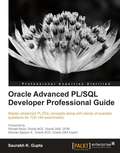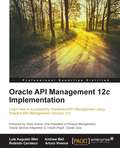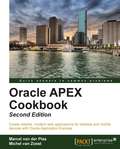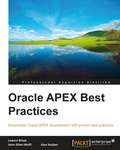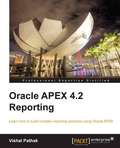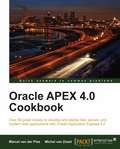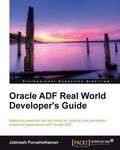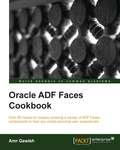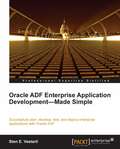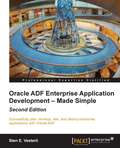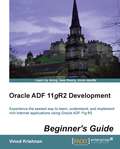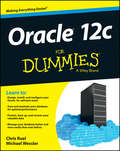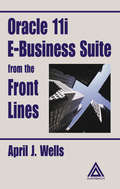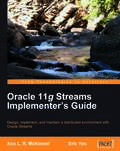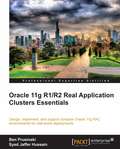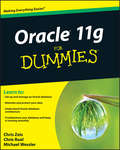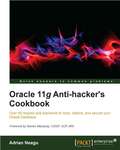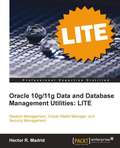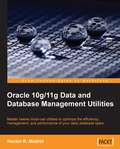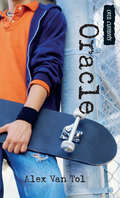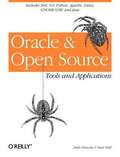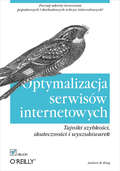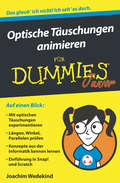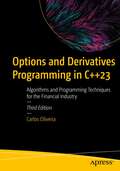- Table View
- List View
Oracle Advanced PL/SQL Developer Professional Guide
by Saurabh K. GuptaThis book is packed with real world examples that cover all the advanced features of PL/SQL. In turn, each major certification topic is covered in a separate chapter that makes understanding concepts easier. At the end of each chapter, you will find plenty of practice questions to strengthen and test your learning.If you are a PL/SQL developer looking for deeper insight and a move from mid-level programmer to professional database developer, then this is the best guide for you. This book is also an ideal guide for all the Associate level PL/SQL programmers who are preparing for the Professional 1Z0-146 certification. This book assumes you have prior knowledge of PL/SQL programming.
Oracle API Management 12c Implementation
by Andrew Bell Luis Augusto WeirLearn how to successfully implement API management using Oracle's API Management Solution 12c About This Book * Explore the key concepts, goals, and objectives of API Management and learn how to implement it using the Oracle API Management Solution * Understand the concepts and objectives of the Application Service Governance (ASG), along with the governance framework that encompasses people, processes, and technology * Get to grips with API Management readiness assessments, gap analysis, digital reference architecture, and implementation roadmaps Who This Book Is For This book is for Enterprise Architects, Solution Architects, Technical Architects, and SOA and API consultants who want to successfully implement API Management using the Oracle API Management Solution products. What You Will Learn * Understand how to manage a set of APIs * Discover the differences and similarities between API Management and SOA Governance, and where and how these two disciplines converge into Application Services Governance (ASG) * Grasp information about ASG and how to define an ASG governance framework * Understand the challenges for organizations looking to expose APIs to the external world. Identify common scenarios and how to solve them * Define an Oracle API management deployment topology * Install and configure Oracle API Catalog (OAC), Oracle API Manager (OAPIM), and Oracle API Gateway (OAG) * Learn about API subscriptions and API community management with the OAPIM portal * Implement Oracle API Manager (OAPIM) including creation, publishing, management and deprecation of APIs In Detail Oracle SOA Governance is a comprehensive, service-orientated governance solution that is designed to make the transition to SOA easier. API management is the discipline that governs the software development lifecycle of APIs. It defines the tools and processes needed to build, publish and operate APIs including the management of the community of developers around it. This book illustrates how to successfully implement API Management in your organization. To achieve this, the importance of defining an API management strategy and implementation roadmap so that capabilities are implemented in the right order and timeframes is described. It starts by describing all of the fundamental concepts around API Management and related disciplines such as SOA Governance and DevOps in order to dispel the confusion surrounding these topics. The book then takes you on the journey of implementing API Management, using a realistic case study of an organization that needs an API Management solution. You will start by identifying the key business drivers to implement APIs and then create an API Management strategy and a roadmap to realize this strategy. You'll then go through a number of use cases, each focused on addressing specific business requirements. These will help you understand each of the Oracle API Management products, how they fit into an overall architecture, and how to implement them. The book concludes by providing some tips and guidelines around defining a deployment topology for the Oracle API Management products and the steps to install them. Style and approach This book is a comprehensive guide to successfully implementing a complete API Management solution from inception to implementation. The initial chapters introduce you to Oracle SOA Governance and API Management and from there, chapters are mainly hands-on and provide a full step-by-step walkthrough of how to implement the products of the Oracle API management solution to address realistic use cases.
Oracle APEX Cookbook - Second Edition
by Marcel Van Plas Michel Van ZoestAs a Cookbook, this book enables you to create APEX web applications and to implement features with immediately usable recipes that unleash the powerful functionality of Oracle APEX 4.2. Each recipe is presented as a separate, standalone entity and the reading of other, prior recipes is not required.It can be seen as a reference and a practical guide to APEX development.This book is aimed both at developers new to the APEX environment and at intermediate developers. More advanced developers will also gain from the information at hand.If you are new to APEX you will find recipes to start development and if you are an experienced user you will find ways to improve your productivity and efficiency and make the most of APEX to enhance your applications.A little knowledge of PL/SQL, HTML and JavaScript is assumed.
Oracle APEX Best Practices
by Learco Brizzi Iloon Ellen Wollf Alex NuijtenIn clearly written chapters you will be guided through different aspects of Oracle Application Express. Varying from setting up your environment to maximizing SQL and PL/SQL. Examples are given based on a simple but appealing case. This book is filled with best practices on how to make the most of Oracle APEX. Developers beginning with application development as well as those who are experienced will benefit from this book. You will need to have basic knowledge of SQL and PL/SQL to follow the examples in this book.
Oracle APEX 4.2 Reporting
by Vishal PathakOracle APEX 4.2 Reporting is a practical tutorial for intermediate to advanced use, with plenty of step-by-step instructions and business scenarios for understanding and implementing the ins and outs of making reports."Oracle APEX 4.2 Reporting" is for you if you design or develop advanced solutions in APEX or wish to know about the advanced features of APEX. If you wish to have a 360 degree view of reporting technologies or work in a complex heterogeneous enterprise, this is a must-have.
Oracle APEX 4.0 Cookbook
by Michel Van ZoestAs a cookbook, this book enables you to create APEX web applications and to implement features with immediately usable recipes that unleash the powerful functionality of Oracle APEX 4.0. Each recipe is presented as a separate, standalone entity and reading of other prior recipes is not required. It can be seen as a reference and a practical guide to APEX development. This book is aimed both at developers new to the APEX environment and at intermediate developers. More advanced developers will also gain from the information at hand. If you are new to APEX you will find recipes to start development. If you are an experienced user you will find ways to work smarter and more easily with APEX and enhance your applications. A little knowledge of PL/SQL, HTML and JavaScript is assumed.
Oracle ADF Real World Developer’s Guide
by Jobinesh PurushothamanThis book is written in simple, easy to understand format with lots of screenshots and step-by-step explanations,If you are an ADF developer looking forward to building healthy and better performing applications using Oracle ADF, then this is the best guide for you. You need to be proficient with Java and ADF before getting started with this book.
Oracle ADF Faces Cookbook
by Amr GawishThis is a cookbook that covers more than 80 different recipes to teach you about different aspects of Oracle ADF Faces. It follows a practical approach and covers how to build your components for reuse in different applications. This book will also help you in tuning the performance of your ADF Faces application. If you are an ADF developer who wants to harness the power of Oracle ADF Faces to create exceptional user interfaces and reactive applications, this book will provide you with the recipes needed to do just that. You will not need to be familiar with Oracle ADF Faces, but you should be comfortable with Java application development, Java EE frameworks, and JSF. This book is also for ADF developers who know how to use Oracle ADF Faces but who want to know what's new in Oracle ADF Faces 12c.
Oracle ADF Enterprise Application Development—Made Simple
by Sten E. VesterliThis book is written in an easy-to-read style, following an enterprise development process through all the phases from proof of concept to initiation and setup to development and on to integration testing and deployment. Concepts are illustrated with real-world examples and the approaches and methods are explained step by step.This book is for developers in general - both web developers and developers experienced with classic 4GL tools like Oracle Forms - who wish to learn how to develop modern, user-friendly web applications in an Oracle environment. It is for novice ADF developers who wish to learn how to use JDeveloper and ADF, as well as for more experienced ADF developers who wish to improve their knowledge and understanding of ADF and how to use it effectively.
Oracle ADF Enterprise Application Development – Made Simple: Second Edition
by Sten E. VesterliThis book is written in an easy-to-understand style, following an enterprise development process through all the phases of development and deployment. Concepts are illustrated with real-world examples and the methods used are explained step-by-step. This book is for Oracle developers looking to start using Oracle's latest development tool and J2EE developers looking for a more productive way to build modern web applications. This book will guide you through the creation of a successful enterprise application with Oracle ADF 12c, and therefore it assumes you have basic knowledge of Java, JDeveloper, and databases.
Oracle ADF 11gR2 Development Beginner's Guide
by Vinod KrishnanOracle ADF 11gR2 Development Beginner's Guide will cover the basics of Oracle ADF 11g development and will then work through more complex topics as the reader gains more skills. This book will follow a tutorial approach with the content and tasks getting more advanced throughout.This book is intended for beginners who know a little about Java programming and would like to learn how to develop rich web applications using the Oracle Application Development Framework.
Oracle 12c For Dummies
by Chris Ruel WesslerDemystifying the power of the Oracle 12c databaseThe Oracle database is the industry-leading relational database management system (RDMS) used from small companies to the world's largest enterprises alike for their most critical business and analytical processing. Oracle 12c includes industry leading enhancements to enable cloud computing and empowers users to manage both Big Data and traditional data structures faster and cheaper than ever before. Oracle 12c For Dummies is the perfect guide for a novice database administrator or an Oracle DBA who is new to Oracle 12c. The book covers what you need to know about Oracle 12c architecture, software tools, and how to successfully manage Oracle databases in the real world.Highlights the important features of Oracle 12cExplains how to create, populate, protect, tune, and troubleshoot a new Oracle databaseCovers advanced Oracle 12c technologies including Oracle Multitenant--the "pluggable database" concept--as well as several other key changes in this releaseMake the most of Oracle 12c's improved efficiency, stronger security, and simplified management capabilities with Oracle 12c For Dummies.
Oracle 11i E-Business Suite from the Front Lines
by April J. WellsOracle 11i E-Business Suite from the Front Lines is the first book to compile the tips, techniques, and practical advice for administering Oracle E-Business Suite 11i. The author examines Active Directory Utilities, patching, cloning, and the new features that 11i brings to the market. The book benefits those with limited experience with Oracle App
Oracle 11g Streams Implementer's Guide
by Ann L. Mckinnell Eric YenThis book has a tutorial approach that provides both theoretical explanations and practical step-by-step examples using familiar Oracle demo schemas. Step-by-step examples include use of both Enterprise Manager and the SQLPLUS command-line interface. The authors have combined their experiences of working with customers in Oracle Support, Oracle training and education, and Oracle consulting, to identify the most common areas of confusion and misinterpretation experienced by Oracle Streams users. This book highlights these areas and focuses on bringing clarity and understanding to the reader. This book is for users who have implemented, or are about to implement, a distributed database environment using Oracle Streams replication. The reader is expected to have an intermediate understanding of Oracle database technology. This book is mainly intended for use by: Oracle Database Administrators responsible for the implementation and maintenance of an Oracle Streamed environment, System and Database Architects responsible for the design of distributed database environments using Oracle Streams Readers with limited knowledge of basic Oracle database technology can benefit from Chapters 1 and 2, which cover Oracle Streams Components and Design Considerations.
Oracle 11g R1/R2 Real Application Clusters Essentials
by Ben Prusinski Syed Jaffer HussainThis book documents how to administer a complex Oracle 11g RAC environment. It covers new RAC components such as ASM's new features, performance tuning, and troubleshooting. It contains real world examples, expert tips, and troubleshooting advice. This book focuses on Oracle RAC 11g R1 with additional 11g R2 information included. If you are an Oracle DBA who wants to administer Real Application Clusters, then this book is for you. Basic understanding of Oracle DBA is required. No experience of Oracle RAC is required.
Oracle 11g For Dummies
by Chris Ruel Chris Zeis WesslerAre you a seasoned system administrator charged with setting up an Oracle database? Or did you suddenly become a DBA by default? If database administration with Oracle is part of your job, you'll be glad to have Oracle 11g For Dummies in your cubicle.This nuts-and-bolts guide walks you through the mysteries of Oracle and database administration. You'll learn how to understand Oracle database architecture, set up and manage an Oracle database, and keep it running in tiptop form. Oracle 11g For Dummies covers:The building blocks behind the database engine as well as Oracle's physical and logical structuresHardware, software, system, and storage requirements for implementationHow to recognize and accommodate the differences between Oracle installations on Windows and on Linux/UNIXDaily and intermittent tasks necessary to keep your database running properlyHow to assess potential threats to your database, configure Oracle Recovery Manager, and set up backup and recovery proceduresWhen to use online, offline, controlfile, and archivelog backupsTroubleshooting methodology and how to use Oracle database logs and other diagnostic utilitiesDifferent ways to manage your databaseHow to automate jobs with the Oracle SchedulerUsing SQL in Oracle, and a great deal moreCompletely up to date for the newest release of Oracle, Oracle 11g For Dummies will give you both the information and the confidence to set up and maintain an Oracle database for your organization.
Oracle 11g Anti-hacker's Cookbook
by Adrian NeaguThis cookbook has recipes written in simple, easy to understand format with lots of screenshots and insightful tips and hints. If you are an Oracle Database Administrator, Security Manager or Security Auditor looking to secure the Oracle Database or prevent it from being hacked, then this book is for you. This book assumes you have a basic understanding of security concepts.
Oracle 10g/11g Data and Database Management Utilities: LITE
by Hector R. MadridThis practical, hands-on book is specifically designed to improve the way you use and work with Oracle database utilities. The material has been carefully selected from Packt's fuller Oracle 10g/11g Data and Database Management Utilities title. The full edition of the book covers a number of additional utilities including Data Pump, SQL*Loader, Recover Manager, and more! This book is aimed at all Oracle professionals who interact with the database through the data and database utilities and are willing to optimize their interaction with it.
Oracle 10g/11g Data and Database Management Utilities
by Hector R. MadridThis book is written using a practical approach that guides you through different practical scenarios. It provides a brief introduction to the topics; this way you can quickly get to know the main features, start being productive with the tool, and grow with it at a fast pace. You won't have to spend too much time getting to the basics of the tool and can immediately progress towards the advanced tips. Using this practical approach you don't have to spend valuable time trying to decipher arid reference manuals; you can easily set up the practical scenarios, and try to follow up the presentations. The images used in the book come from real scenarios, and the output is always explained so you can easily interpret what is being displayed on the screen after issuing the commands. This book is aimed at all Oracle professionals who interact with the database through the data and database utilities and are willing to optimize their interaction with it. Entry-level users will get acquainted with the best practices to get their job done in a timely and efficient manner. Advanced users will find useful tips and How-Tos that will help them focus on getting the most out of the database utilities and fine-tune batch processing.
Oracle (Orca Currents)
by Alex Van TolOwen has a crush on Kamryn. Kamryn has a crush on Owen's brother Kyle. Owen knows extreme action is necessary to make sure Kamryn does not end up dating his brother, a jerk who manipulates every situation to get what he wants. So what does Owen do? He manipulates the situation. With the help of his friend Hannah, Owen sets up a blog called The Oracle that gives out relationship advice to local teens. Everything seems to be going great. Hannah and Owen are having fun, and Kamryn seems to be following The Oracle's advice and taking an interest in Owen. Owen thinks he's got it made, but he soon discovers that fraudulent tactics have their consequences.
Oracle & Open Source
by Andy Duncan Sean HullOracle and Open Source is the first book to tie together the commercial world of Oracle and the free-wheeling world of open source software. As this book reveals, these two worlds are not as far apart as they may seem. Today, there are many excellent and freely available software tools that Oracle developers and database administrators can use, at no cost, to improve their own coding productivity and their system's performance. Moreover, many of the finest Oracle developers are now making their source code freely available so their peers can build upon this code base. Oracle Corporation is even porting its RDBMS to Linux and starting to incorporate a growing number of open source tools in the company's own software. Oracle and Open Source describes close to 100 open source tools you can use for Oracle development and database administration, from large and widely known open source systems (like Linux, Perl, Apache, TCL/Tk and Python) to more Oracle-specific tools (like Orasoft, Orac, OracleTool, and OraSnap). You'll learn how to obtain the software and how to adapt it to best advantage. The book abounds with code examples, download and installation instructions, and helpful usage hints. Not only does it tell you how to find and use existing open source code; Oracle and Open Source gives you the details and the motivation to build your own open source contributions and release them to the Oracle community. You'll learn all about tools like the Oracle Call Interface (OCI) and Perl-DBI (Database Interface), which provide the glue allowing new open source tools to link into commercial Oracle software. With Oracle and Open Source as a guide, you'll discover an enormous number of highly effective open source tools, while getting involved with the thriving community of open source development.
Optymalizacja serwisów internetowych. Tajniki szybko?ci, skuteczno?ci i wyszukiwarek
by Andrew B. KingPoznaj sekrety tworzenia popularnych i dochodowych witryn internetowych! Jak poprawi? widoczno?? serwisu w wyszukiwarkach?Jak zoptymalizowa? p?atne kampanie reklamowe?Jak odnie?? sukces w Internecie?Celem optymalizacji witryny WWW jest przede wszystkim maksymalizacja przychodów z serwisu i podniesienie komfortu u?ytkowników. Aby ten cel osi?gn??, trzeba spe?ni? kilka podstawowych warunków. Po pierwsze nale?y zadba? o to, aby serwis mo?na by?o ?atwo odszuka? w sieci. Po drugie korzystanie z niego nie mo?e sprawia? trudno?ci, a po trzecie powinien on by? szybki, atrakcyjny i interaktywny. Krótko mówi?c, dobry serwis musi by? funkcjonalny i wydajny. Aby osi?gn?? sukces w sieci, nale?y zatem wybra? w?a?ciwe metody i przyj?? skuteczn? strategi? dzia?ania. Jakie to techniki i jak je stosowa?, dowiesz si? w?a?nie z tej ksi??ki.Ksi??ka "Optymalizacja serwisów internetowych. Tajniki szybko?ci, skuteczno?ci i wyszukiwarek" wska?e Ci mo?liwo?ci tworzenia i optymalizacji serwisu internetowego, pozwalaj?ce w znacznym stopniu ograniczy? inwestycje w marketing, a jednocze?nie zyska? wielu klientów. Z tego podr?cznika dowiesz si?, jak zoptymalizowa? serwis pod k?tem wyszukiwarek, na czym polega w?a?ciwy dobór s?ów kluczowych, jak zbudowa? architektur? CSS i tworzy? ciekawe rozwi?zania, opieraj?ce si? na Ajaksie. Ponadto nauczysz si? optymalizowa? kampanie reklamowe dzi?ki stosowaniu perswazyjnej tre?ci reklam. Po tej lekturze b?dziesz umia? stworzy? wydajny, funkcjonalny, a przy tym popularny i dobrze zarabiaj?cy serwis internetowy. Optymalizacja pozycji serwisu w wyszukiwarkachNarz?dzia do analizowania s?ów kluczowychNag?ówki przyci?gaj?ce uwag?Optymalizacja reklam p?atnych (PPC)Dobór grupy docelowej i kwalifikowanie odwiedzaj?cychWykorzystanie metryk do ustalenia bud?etuOptymalizacja wspó?czynnika konwersjivOptymalizacja stron WWWBudowanie architektury CSSTworzenie w?asnych rozwi?za?, opartych na AjaksieZaawansowana optymalizacja serwisów WWWMetryki optymalizacji wydajno?ciOptymalizuj serwis i dochody!
Optische Täuschungen animieren für Dummies Junior (Für Dummies)
by Joachim WedekindDu wirst deinen Augen nicht mehr trauen. Dieses Buch enthält einige bekannte und weniger bekannte optische Täuschungen: Quadrate rutschen, die gar nicht rutschen dürften, Linien springen, die gar nicht springen dürften. Du siehst kurze und lange Linien, obwohl alle Linien gleich lang sind. Und das Beste ist: Du kannst diese optischen Täuschungen mit der Programmiersprache Snap! selber erzeugen. Und dann kannst du alle Eigenschaften verändern. Spiele mit den Abständen der Linien, ihrer Dicke und Farbe und vielem anderen mehr und überprüfe, ob sich der optische Eindruck verändert. Bestens geeignet für Kinder und Jugendliche ab 10 Jahre.
Options: The Secret Life of Fake Steve Jobs
by Daniel LyonsWelcome to the mind—to the world—of Fake Steve Jobs. Fake Steve the counterintuitive management guru: “Obviously we can’t literally put our employees’ lives at risk. But we have to make them feel that way.” Fake Steve the celebrity hobnobber: “I like Bono. He’s the only person I know who’s more self-absorbed than I am.”
Options and Derivatives Programming in C++23: Algorithms and Programming Techniques for the Financial Industry
by Carlos OliveiraThis book is a hands-on guide for programmers who want to learn how C++ is used to develop solutions for options and derivatives trading in the financial industry. It explores the main algorithms and programming techniques used in implementing systems and solutions for trading options and derivatives. This updated edition will bring forward new advances in C++ software language and libraries, with a particular focus on the new C++23 standard. The book starts by covering C++ language features that are frequently used to write financial software for options and derivatives. These features include the STL (standard template library), generic templates, functional programming, and support for numerical code. Examples include additional support for lambda functions with simplified syntax, improvements in automatic type detection for templates, custom literals, modules, constant expressions, and improved initialization strategies for C++ objects. This book also provides how-to examples that cover all the major tools and concepts used to build working solutions for quantitative finance. It discusses how to create bug-free and efficient applications, leveraging the knowledge of object-oriented and template-based programming. It has two new chapters covering backtesting option strategies and processing financial data.. It introduces the topics covered in the book in a logical and structured way, with lots of examples that will bring them to life. Options and Derivatives Programming in C++23 has been written with the goal of reaching readers who are looking for a concise, algorithms-based book that provides basic information through well-targeted examples and ready to use solutions. What You Will Learn Gain insight into the fundamental challenges of the options and derivatives marketMaster the features of the C++ language used in quantitative financial programmingUnderstand quantitative finance algorithms for options and derivativesBuild pricing algorithms around the Black-Scholes model, and use binomial and differential equations methods Who This Book Is For Professional developers who have some experience with the C++ language and would like to leverage that knowledge into financial software development.
